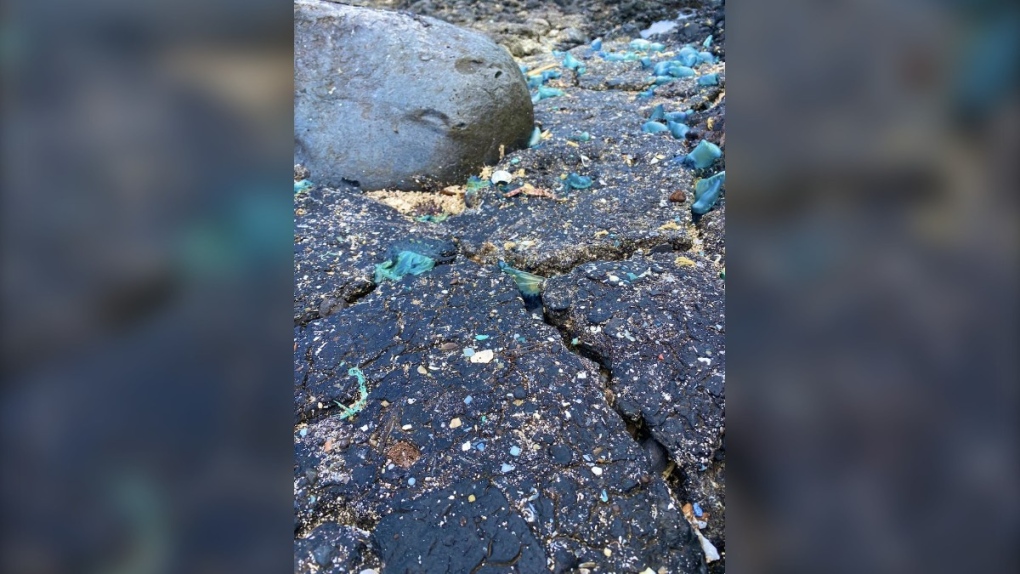PLASTIC AND ASPHALT
Plastic pollution now combining with tar to form ocean-threatening 'plastitar'
Plastitar found in Arenas Blancas, El Hierro, Canary Islands. (University of La Laguna)
Michael Lee
CTVNews.ca Writer
Published June 11, 2022
Scientists have identified a new type of coastal pollution composed mainly of tar and plastic, material so unique in its combination that researchers are suggesting it receive its own name: "plastitar."
A research group from the University of La Laguna in the Canary Islands, a Spanish region located west of Morocco, recently published details of the pollution in the journal Science of the Total Environment.
And they say it could pose a wide-ranging threat to the marine ecosystem "with unknown environmental consequences."
Michael Lee
CTVNews.ca Writer
Published June 11, 2022
Scientists have identified a new type of coastal pollution composed mainly of tar and plastic, material so unique in its combination that researchers are suggesting it receive its own name: "plastitar."
A research group from the University of La Laguna in the Canary Islands, a Spanish region located west of Morocco, recently published details of the pollution in the journal Science of the Total Environment.
And they say it could pose a wide-ranging threat to the marine ecosystem "with unknown environmental consequences."
RELATED LINKS Plastitar: A new threat for coastal environments
They found that "plastitar" originates from crude oil spills from ships. Once the oil reaches coastlines it covers rocks, allowing plastics to embed in the tar.
The study found evidence of "plastitar" in several areas of the Canary Islands, including a nature reserve and some beaches.
These areas were identified as hotspots due to the large amount of plastic waste they receive as a result of year-round dominant north and northeast winds, the study says.
However, the researchers say they are not ruling out other coastal areas where "plastitar" may be located.
"A relevant aspect about the presence of tar on coastal environments is the fact that it contains hydrocarbons that can be photo-oxidized and impact negatively the marine ecosystem altering the ecological equilibria," the study says.
The researchers point to the example of polycyclic aromatic hydrocarbons (PAHs), which are present in tar and can be toxic to aquatic organisms. PAHs also act as endocrine disruptors and can be carcinogenic.
The combination of tar and plastic also has a negative visual impact, the scientists say, and is likely present in other coastal areas around the world.
"Its combination with plastic materials clearly supposes a double threat to the marine ecosystem with unknown environmental consequences, since plastics can be ingested by marine organisms causing intestinal blockage, internal injuries, oxidative stress and damage, inflammatory responses, among other important issues," the researchers say.
"Therefore, further research is necessary to fully understand the potential effects of this particular plastic formation, which is probably present in many parts of the globe.
The plastic found included polyethylene and polypropylene microplastics, types of low-density polymers that are among the most commonly used in the world.
The microplastics ranged between one and five millimetres in size. Further analysis found nearly 91 per cent of the microplastics studied were polyethylene and more than nine per cent were polypropylene.
The researchers say this matches previous studies they have done, which found these types of microplastics on beaches of the Canary Islands.
Wood, glass, rocks and sand also were found in the "plastitar" but to a lesser extent, along with small pieces of rope.
The researchers say "plastitar" can be included as one of several other new formations linked to plastic waste in the marine environment.
These include plastiglomerates, which mainly form from the uncontrolled burning of waste and can include melted plastic, beach sediment or sand, basaltic lava and organic debris; plasticrusts or plastic fragments embedded in wave-exposed coastal rocks; pyroplastics or melted plastic with a rocky appearance; and anthropoquinas or sedimentary rocks containing plastics, which gets its name from the Anthropocene or the unofficial geological epoch defined as when human activity began to have a significant impact on the climate and ecosystems.
No comments:
Post a Comment